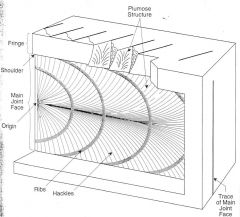![]()
![]()
![]()
Use LEFT and RIGHT arrow keys to navigate between flashcards;
Use UP and DOWN arrow keys to flip the card;
H to show hint;
A reads text to speech;
22 Cards in this Set
- Front
- Back
|
joint |
A natural fracture that forms by tensile loading-walls of fracture move apart slightly as joint develops |
|
|
joint geometry |
planar and often smooth, no appreciable displacement. Most abundant structural element in crust Commonly elliptical in 3-D. Usually confined in beds and grow to elongate shapes. |
|
|
plumose structure |
A subtle roughness on the surfaces of some joints; resembles imprint of a feather. Due to inhomogeneity of rock. "feather structure" |
|
|
fringe hackles |
At termination of bed. Joint rotates away from main structure joint, stress concentrated at crack tips. |
|
|
joint anatomy |

|
|
|
arrest lines |
pause in joint propogation |
|
|
twist hackle |
As the fracture tip grows it may encounter a space where it is must rotate with a changing stress configuration…like near a bedding contact. This often occurs in a zone near the margins of beds known as the ‘Hackle Fringe’ |
|
|
systematic joints |
Planar joints that comprise a family of joints that are all parallel or subparallel and maintain the rough spacing. |
|
|
non-systematic joint |
Joints that are not parallel or subparallel or evenly spaced. |
|
|
joint set |
A group of systematic joints.Two or more joint sets that intersect at fairly constant angles comprise a ‘Joint System’ |
|
|
Three competing mechanisms that contribute to joint formation during uplift and erosion |
(1) Contraction during cooling (2) Poisson effect- e.g., rock expands in vertical direction and contracts in horizontal direction during unloading (3) Membrane effect- expansion due to increase in-curvature of layer |
|
|
cooling joints |
formed by thermal contraction Ex. lavas erupted at surface, swelled up in crater -loose 10% of volume as melt becomes solid -confined melt looses heat at top and bottom -melt mainly homogeneous |
|
|
exfoliation joints |
Form by unloading of bedrock through erosion.They form parallel to topography. Common in granitic rocks because at high pressure; homogeneous. |
|
|
tectonic joints |
Form by tectonic stresses as opposed to stresses induced by topography. Folding, shortening, collapse on itself. |
|
|
joint shadows |
immediate area around fracture where no other cracks/joints can happen |
|
|
sigmodal joints |
E-W joint forms first, then N-S ones curve. Maybe not even meet at E-W boundary. |
|
|
hexagonal joints |
need slow heat loss |
|
|
joint analysis |
determine orientation of tectonic stresses |
|
|
shear fractures |
en echelon tension gashes -form ~45 degrees from plane of max. shear stress -preexisting vein material rotates while new vein material grows -as fracture is sheared, core is subject to ccw rotation |
|
|
vein filling |
-fibrous nature -crystals grow parallel to direction of expansion -thickness of crystals related to dilation -sometimes fractures in middle of crystals |
|
|
syntaxial growth in veins |
youngest crystals in middle |
|
|
antitaxial growth in veins |
oldest crystals in middle |

